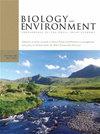NUTRIENT LIMITATION AND PHOSPHATE REGENERATION IN ARTIFICIAL CUTAWAY PEATLAND LAKES
IF 0.6
4区 环境科学与生态学
Q4 ENVIRONMENTAL SCIENCES
Biology and Environment-Proceedings of the Royal Irish Academy
Pub Date : 2022-01-01
DOI:10.3318/BIOE.2007.107.3.147
引用次数: 2
Abstract
Abstract:Increasingly large areas of Ireland's emerging cutaway peatlands are being flooded to create a linked network of lakes and wetlands designed for conservation and amenity purposes. The current study examined water quality in four artificial cutaway peatland lakes over three years (2001-2004), with particular focus on nutrient dynamics and the potential for phosphate to be regenerated from the organic phosphorus pool via biotic and abiotic processes. The cutaway lakes contrasted strongly in both their physico-chemical characteristics, trophic statuses and limiting nutrient states. Two of the alkaline mesotrophic study lakes were annually N-limited in summer, while the acidic eutrophichypertrophic study lake underwent a transition to more sustained N-limitation. Laboratory experiments indicated a considerable potential for soluble reactive phosphorus (SRP) to be regenerated from the dissolved organic phosphorus pool by phosphatase enzyme hydrolysis (mean 2.6µg 1⁻¹). UV-induced SRP regeneration was found to play a lesser role (mean 0.9µg 1⁻¹), particularly in the dystrophic study lake, while combined UV and enzymatic hydrolysis produced an intermediate response (mean 2.3µg 1⁻¹). With all three mechanisms, the quantity of SRP regenerated appeared to be independent of lake trophic status. The current data provide some evidence that the regeneration of SRP from the large organic phosphorus pool in cutaway peatland lakes can help maintain a constant supply of bioavailable phosphorus, potentially contributing to the prevalence of N-limiting conditions in these systems.人工挖潜泥炭地湖泊的养分限制与磷酸盐再生
摘要:越来越多的爱尔兰新兴泥炭地被淹没,形成了一个连接湖泊和湿地的网络,旨在保护和美化环境。本研究历时三年(2001-2004年)考察了四个人工泥炭地湖泊的水质,特别关注营养动态和通过生物和非生物过程从有机磷池中再生磷酸盐的潜力。切割后的湖泊在物理化学特征、营养状态和限制营养状态上都有强烈的对比。两个碱性中营养研究湖泊每年夏季都有氮限制,而酸性富营养化研究湖泊则经历了向更持续的氮限制的过渡。实验室实验表明,通过磷酸酶水解从溶解的有机磷池中再生可溶性活性磷(SRP)的潜力相当大(平均2.6µg 1⁻¹)。紫外线诱导的SRP再生被发现起较小的作用(平均0.9µg 1⁻¹),特别是在营养不良的研究湖中,而紫外线和酶水解的结合产生了中间反应(平均2.3µg 1⁻¹)。在这三种机制下,再生SRP的数量似乎与湖泊营养状况无关。目前的数据提供了一些证据,表明从泥炭地湖泊的大型有机磷池中再生的SRP可以帮助维持生物可利用磷的持续供应,这可能有助于这些系统中n限制条件的流行。
本文章由计算机程序翻译,如有差异,请以英文原文为准。
求助全文
约1分钟内获得全文
求助全文
来源期刊
CiteScore
1.10
自引率
0.00%
发文量
6
审稿时长
>36 weeks
期刊介绍:
The journal aims to offer a broad coverage of the subject area, including the following:
- biology and ecology of the Irish flora and fauna
- microbial ecology
- animal, plant and environmental physiology
- global change
- palaeoecology and palaeoclimatology
- population biology; conservation of genetic resources
- pollution and environmental quality; ecotoxicology
- environmental management
- hydrology
- land use, agriculture, soils and environment.
Submissions on other relevant topics are also welcome, and papers of a cross-disciplinary nature are particularly encouraged.

 求助内容:
求助内容: 应助结果提醒方式:
应助结果提醒方式:


